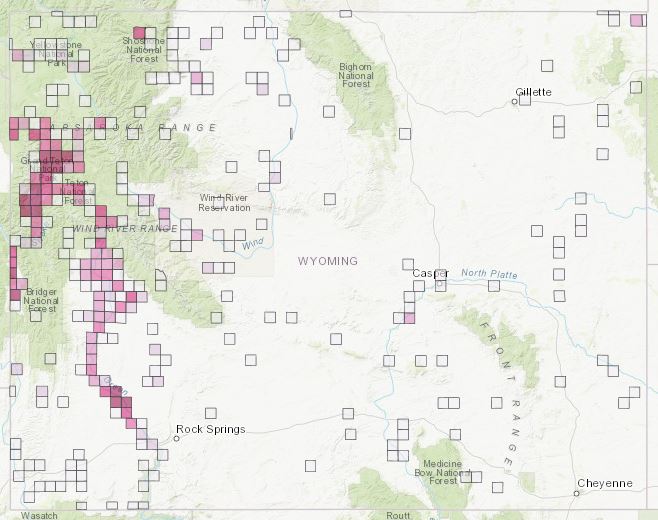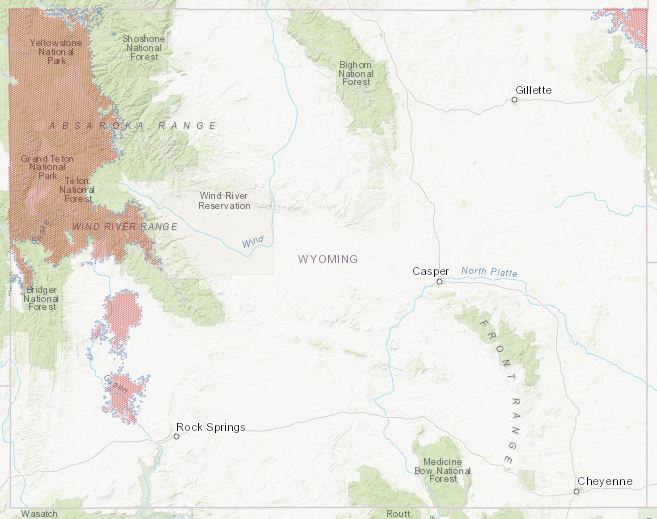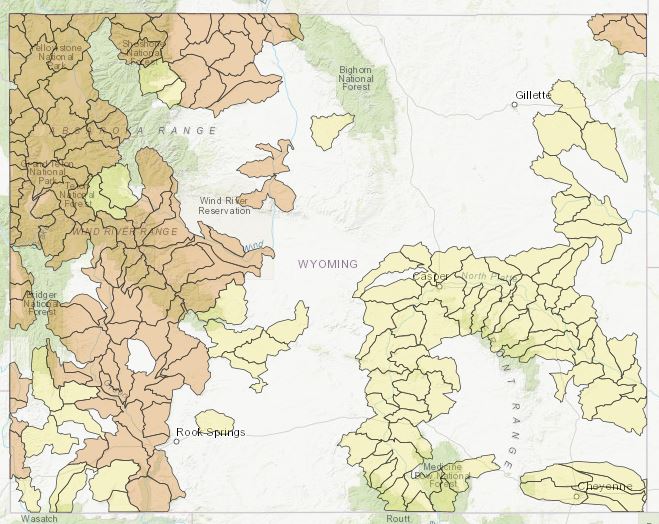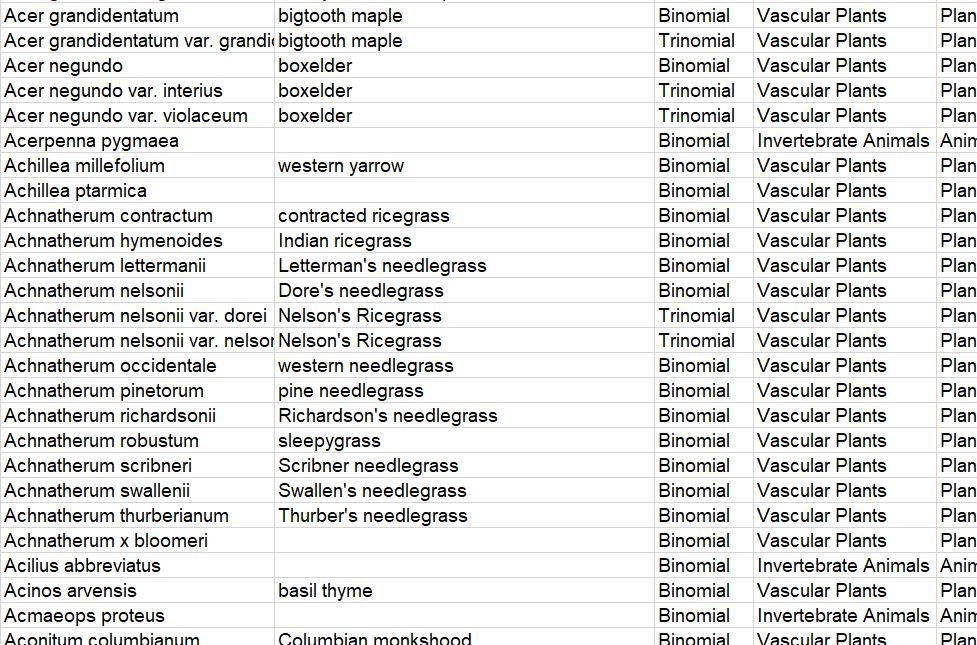Currently, our web mapping services include:
This service consists of observation data summarized to townships, conveying a quick picture of where the taxon has been observed in the state. Public Land Survey System Townships (6 mi. x 6 mi. square) are used to summarize data in accordance with our data sensitivity policies. The default symbology for this service depicts the year of the most recent observation in WYNDD's database that falls within each township for the taxon. Alternatively, townships can be symbolized based on the number of observations per township. Refer to the generalized observations data dictionary, below, for more information about the attribute information included with this service.

Generalized Distribution Models
This service contains predictive distribution models generated by WYNDD for Wyoming taxa, generalized to 1-mile hexagons. Distribution models represent predictions of where a taxon might occur, based on the similarity in environmental characteristics of an area to those found at points of known occurrence for the taxon. The default symbology of this service shows the proportion of each hexagon that is predicted as "present" for the taxon of interest. Generalized distribution models are clipped to the current range boundary for the taxon, to prevent predicted occurrence outside of the accepted range for the species. Refer to the generalized distribution model data dictionary, below, for for more information about the attribute information included with this service. See our Predictive Distribution Models page for more information about these data products. Not all Wyoming taxa currently have distribution models available.

This service contains range maps for Wyoming taxa. In addition to a spatial representation of where a taxon occurs in the state, WYNDD's range data also include information about seasonal use, origin, reintroductions, and more. All taxa at the species level or finer that are thought to occur in Wyoming have range maps, though at present many taxa do not have the more detailed, watershed-based range maps available. Refer to the range map data dictionary, below, for for more information about the attribute information included with this service, and see our Range Maps page for more information about WYNDD's range mapping process and data.

This is a non-spatial data service that provides a list of all taxa thought by WYNDD to occur in the state of Wyoming, at the species level and below (subspecies, variety, population). Generally, this service is most useful as a taxonomic index for our other data services, allowing users (typically developers) to determine which taxa are included in the other data services. Most users will find it more convenient to reference WYNDD's Species List Page. For those who wish to use the species list data service, please see the species list data dictionary for this service, below.

Using Our Web Mapping Services in Desktop GIS Software
Contact support@wyndd.org for any questions regarding use of our web mapping services in desktop GIS software.
Terms of Use for Our Web Mapping Services in Third Party Web Applications
Please contact support@wyndd.org for more information about using our web mapping services in your applications.
Generalized Observations Service Data Dictionary
The attributes contained within the generalized observation service are as follows:
| Attribute | Description |
|---|---|
| FID | Unique identifier for table row (for internal use only) |
| township | Unique identifier for Public Land Survey System township represented by the record |
| taxon_id | Unique identifier for the taxon represented by the record |
| sciname | Accepted scientific name for the taxon represented by the record |
| comname | Accepted common name for the taxon represented by the record |
| obs_count | Number of distinct observations recorded within the township for the taxon |
| last_year | Year of the most recent observation for the taxon within the township |
| geom | Geometry for the township boundary |
| last_refresh | Date when this layer was last updated by WYNDD |
| Attribute | Description |
|---|---|
| FID | Unique identifier for table row (for internal use only) |
| model_hex_id | Unique identifier for generalized model record |
| taxon_id | Unique identifier for the taxon represented by the record |
| sciname | Accepted scientific name for the taxon represented by the record |
| comname | Accepted common name for the taxon represented by the record |
| model_mean | Proportion of the hexagon where the taxon is predicted to be present by the model; 0 values indicate that no portion of the hexagon is predicted present for the taxon, though the hexagon is within the taxon’s accepted range |
| season | Modeled season |
| Summer | Model predicts taxon’s distribution in the summer |
| Winter | Model predicts taxon’s distribution in the winter |
| Year-Round | Model predicts taxon’s year-round distribution |
| model_date | Date the model summarized by this layer was generated |
| model_id | Unique identifier for the distribution model used to generate this summary data |
| hex_id | Unique identifier for the hexagon to which data have been summarized |
| geom_webmerc | Web Mercator geometry for the watershed boundary |
| last_refresh | Date when this layer was last updated by WYNDD |
| Attribute | Description |
|---|---|
| FID | Unique identifier for table row (for internal use only) |
| range_id | Unique identifier for range data record |
| taxon_id | Unique identifier for the taxon represented by the record |
| sciname | Accepted scientific name for the taxon represented by the record |
| comname | Accepted common name for the taxon represented by the record |
| huc10_id | Unique identifier for watershed |
| occurrence | Level of occurrence by the taxon, in the watershed |
| Regular | Taxon is known or strongly suspected to commonly occupy watershed in succeeding years; predictably present |
| Irregular | Taxon is known or strongly suspected to rarely occupy watershed in succeeding years; occupancy unpredictable |
| Absent | Taxon is known or strongly assumed to not occupy watershed at any time of a given year |
| origin | Nativity of the taxon in the watershed |
| Native | Taxon is native to watershed |
| Nonnative | Taxon is not native to watershed |
| None | Taxon is not known to occur in the watershed |
| season | Seasonal occurrence of the of the taxon in the watershed |
| Year-round | Taxon occurs in watershed year-round |
| Summer | Taxon occurs in watershed in summer and in migratory seasons |
| Winter | Taxon occurs in watershed in winter and in migratory seasons |
| Migration | Taxon occurs in watershed in migratory seasons |
| None | Taxon is not known to occur in the watershed in any season |
| detectable | Date range(s) within which taxon is typically detectable in the watershed |
| reprod | Date range(s) within which taxon is thought to reproduce in the watershed |
| spr_migr | Date range for spring migration for taxon in the watershed, if it migrates in/through the watershed |
| fall_migr | Date range for fall migration for taxon in the watershed, if it migrates in/through the watershed |
| dormancy | Date range when the taxon is thought to be dorman, in the watershed |
| geom_webmerc | Web Mercator geometry for the watershed boundary |
| last_refresh | Date when this layer was last updated by WYNDD |
| Attribute | Description |
|---|---|
| FID | Unique identifier for table row (for internal use only) |
| taxon_id | Unique identifier for the taxon represented by the record |
| parent_taxon_id | Unique identifier for the taxonomic unit directly above the taxon represented by the record |
| sciname | Accepted scientific name for the taxon represented by the record |
| comname | Accepted common name for the taxon represented by the record |
| tax_level | Taxonomic level of the taxon represented by the record |
| Binomial | Taxon is a species |
| Trinomial | Taxon is a subspecies |
| Population | Taxon is a population |
| taxgroup | Major taxonomic group to which the taxon belongs |
| Nonvascular Plants | Taxon belongs to one of the plant phyla comprising nonvascular plants (Anthocerotophyta, Marchantiophyta, Bryophyta) |
| Vertebrate Animals | Taxon belongs to the phylum Chordata |
| Invertebrate Animals | Taxon belongs to one of the phyla comprising invertebrate animals (Arthropoda, Platyhelminthes, Gastrotricha, Nematomorpha, Cnidaria, Mollusca, Bryozoa, Nemertea, Rotifera, Nematoda, Tardigrada, Annelida) |
| Vascular Plants | Taxon belongs to one of the plant phyla comprising vascular plants (Coniferophyta, Filicinophyta, Anthophyta, Gnetophyta, Sphenophyta, Lycopodiophyta) |
| kingdom_sci | Kingdom to which the taxon belongs (scientific name) |
| kingdom_com | Kingdom to which the taxon belongs (common name) |
| phylum_sci | Phylum to which the taxon belongs (scientific name) |
| phylum_com | Phylum to which the taxon belongs (common name) |
| class_sci | Class to which the taxon belongs (scientific name) |
| class_com | Class to which the taxon belongs (common name) |
| order_sci | Order to which the taxon belongs (scientific name) |
| order_com | Order to which the taxon belongs (common name) |
| family_sci | Family to which the taxon belongs (scientific name) |
| family_com | Family to which the taxon belongs (common name) |
| genus_sci | Genus to which the taxon belongs (scientific name) |
| genus_com | Genus to which the taxon belongs (common name) |
| binom_sci | Species to which the taxon belongs (scientific name) |
| binom_com | Species to which the taxon belongs (common name) |
| trinom_sci | Subspecies to which the taxon belongs, if subspecies or lower level (scientific name) |
| trinom_com | Subspecies to which the taxon belongs, if subspecies or lower level (common name) |
| pop_sci | Population to which the taxon belongs, if a population (scientific name) |
| pop_com | Population to which the taxon belongs, if a population (common name) |
| wyndd_soc | WYNDD Species of Concern designation, based on rarity, inherent vulnerability, and threats |
| SOC | Species of Concern; taxon is vulnerable to extirpation at the global or state level due to their rarity, inherent vulnerability, or threats |
| SOPC | Species of Potential Concern; taxon is apparently secure at present, but could become vulnerable if circumstances change; these taxa warrant periodic evaluation |
wy_contrib |
Wyoming Contribution Rank; system developed by WYNDD for indicating the contribution of Wyoming populations of a taxon to the rangewide persistence of that taxon |
| Very High | WY populations contribute greatly to the species’ rangewide persistence. Typically applies to species with small continental ranges that are centered on WY. Local endemics are included in this category, along with regional endemics concentrated in Wyoming. |
| High | WY populations contribute substantially to the species’ rangewide persistence when evaluated in combination with populations in adjacent states. Typically applies to species that are more secure in WY than elsewhere and have a moderate proportion of their continental range in WY. Most regional endemics are included in this category. |
| Medium | WY populations contribute to the species’ rangewide persistence, but are apparently no more critical than populations in other states. Typically applies to native, resident taxa that are as secure in WY as elsewhere and have a moderate proportion of their continental range in WY. Disjuncts are included in this category. |
| Low | WY populations contribute minimally to the species’ rangewide persistence. Typically applies to taxa that are more prevalent and secure in other states, and occur only intermittently or peripherally in WY. |
| Very Low | WY populations contribute extremely minimally to the species’ rangewide persistence. Typically applies to taxa that are more prevalent and secure in other states, and occur only intermittently or peripherally in WY. |
| s_rank | WYNDD State Rank, a conservation rank assigned to non-migratory taxa (at the species or subspecies level) by WYNDD biologists; see https://www.uwyo.edu/wyndd/codes-and-definitions/heritage-rank/ and https://www.uwyo.edu/wyndd/codes-and-definitions/state-status/ for information on codes and ranking process |
| g_rank | Global rank for the taxon; see https://www.uwyo.edu/wyndd/codes-and-definitions/heritage-rank/ and www.natureserve.org/explorer/ranking.htm for more information on codes and ranking process |
| usfws_esa | Protective status under the 1973 Endangered Species Act |
| LE | Listed Endangered; for plants this applies to all of a taxon's range; for animals this may apply to only a portion of a taxon's range |
| PE | Proposed Endangered; proposed for listing as Endangered |
| LEXN | Listed Endangered - Nonessential Experimental Population; populations that are considered Endangered but receive lower levels of protection due to their reintroduced, temporary, or otherwise provisional condition |
| LT | Listed Threatened; likely to become Endangered in the near future. For plants this applies to all of a taxon's range; for animals this may apply to only a portion of a taxon's range |
| PT | Proposed Threatened; Proposed for listing as Threatened |
| C | Candidate, Warranted but Precluded; existing biological information supports a formal proposal to list as Endangered or Threatened, but developing a listing regulation is precluded by higher priority listing activities |
| DM | Delisted, formally monitored; Delisted from Endangered or Threatened status |
| PD | Proposed for Delisting; Proposed for delisting from existing status |
| NW | Not warranted; a formal proposal for listing as Endangered or Threatened was recently denied |
| UR | Under review; a petition to list as Endangered or Threatened has been received by USFWS and is awaiting USFWS review |
| WPT | Proposed Threatened, 12-month positive finding |
| usfws_mbta | “Protected,” if the taxon has protections under Title 50, Code of Federal Regulations (CFR), Parts 10, 20, and 21, that provides a list of species protected by the Migratory Bird Treaty Act of 1918 (16 U.S.C. 703-712) |
| mig_gm_brd | Protections exist under USFWS Issuance of Annual Regulations Permitting the Hunting of Migratory Birds;Regulations allowing hunting of migratory birds in the families Anatidae (waterfowl), Columbidae (doves and pigeons), Gruidae (cranes), Scolopacidae (snipe and American woodcock), and Rallidae (rails, coots, gallinules and moorhens) are promulgated annually by the USFWS, and set the context for annual hunting regulations established by the Wyoming Game and Fish Department (WGFD). Hunters must consult state regulations each year for lists of huntable species, season dates, bag limits, and related details. |
| blm_wy | “Sensitive,” if taxon appears on the BLM Wyoming’s Sensitive Species List |
| usfs_sens | Values indicate on which USFS Region’s Sensitive Species list, if any, the taxon appears |
| USFS-R2 | In Wyoming, considered sensitive in Bighorn, Black Hills, Medicine Bow, and Shoshone National Forests, and Thunder Basin National Grassland |
| USFS-R4 | In Wyoming, considered sensitive in Bridger-Teton, Caribou, Targhee, Wasatch-Cache, and Ashley (including Flaming Gorge National Recreation Area) National Forests |
| usfs_solc | Species of Local Concern in the National Forest(s) or Grassland(s) listed in this column |
| BgHrnNF | Bighorn National Forest |
| CTNF | Caribou-Targhee National Forest |
| BlkHlNF | Black Hills National Forest |
| MBNF | Medicine Bow National Forest |
| TBNG | Thunder Basin National Grassland |
| BTNF | Bridger-Teton National Forest |
| wgfd_nss | Wyoming Game and Fish Department’s Native Species Status ranking system; see https://www.uwyo.edu/wyndd/codes-and-definitions/state-status/ and https://wgfd.wyo.gov/Wildlife-in-Wyoming/More-Wildlife/Nongame-Birds for definitions of codes and ranking methods |
| wgfd_tier | Wyoming Game and Fish Department’s NSS-rank based prioritization; see https://www.uwyo.edu/wyndd/codes-and-definitions/state-status/ for further discussion |
| I | Highest priority |
| II | Moderate priority |
| III | Lowest priority |
| wgfd_sgcn | “SGCN” if the taxon is considered a Species of Greatest Conservation Need by the Wyoming Game and Fish Department; see the State Wildlife Action Plan (https://wgfd.wyo.gov/Habitat/Habitat-Plans/Wyoming-State-Wildlife-Action-Plan) for more information |
| wyo_wldbsn | Wyoming Wild Bison areas; Chapter 41, Bison Designated as Wildlife regulation promulgated by authority of W.S. 23-1-302, 11-6-302, 11-18-103, 11-20-101, and 11-20-202. Section 2 (e) "Wild bison" means any bison that is found in the Absoroka wild bison management area or Jackson wild bison herd area that is not a privately owned bison |
| wyo_bga | “Big Game” if managed as a big game species under Title 23, Chapter 1, Article 1, 23-1-101. Definitions of wildlife. (a)(i) "Big game animal" means antelope, bighorn sheep, deer, elk, moose or mountain goat." |
| wyo_fba | “Furbearer” if managed as a furbearing species under Title 23, Chapter 1, Article 1, 23-1-101. Definitions of wildlife. (a)(iii) "Furbearing animal" means badger, beaver, bobcat, marten, mink, muskrat or weasel. |
| wyo_gb | “See Regs” if managed as a game bird species under Title 23, Chapter 1, Article 1, 23-1-101. Definitions of wildlife. (a)(iv) "Game bird" means grouse, partridge, pheasant, ptarmigan, quail, wild turkey, and migratory game birds. "Migratory game bird" means all migratory game birds defined and protected under federal law. Interpretation: federal law = USFWS Migratory Bird Treaty Act (MBTA) which designates all birds in the families Anatidae, Columbidae, Gruidae, Rallidae, and Scolopacidae to be migratory game birds but notes that only those species with designated hunting seasons may be hunted. See updated Wyoming Game and Fish Hunting Regulations for further information. |
| wyo_gf | “See Regs” if managed as a game fish species under Title 23, Chapter 1, Article 1, 23-1-101. Definitions of wildlife. (a)(v) "Game fish" means bass, catfish, crappie, grayling, burbot, northern pike, perch, salmon, sauger, sunfish, trout, walleye, or whitefish unless the species is otherwise designated by the commission in specific waters through rule and regulation. |
| wyo_prota | “Protected” if classified as a “Protected Animal” under Title 23, Chapter 1, Article 1, 23-1-101. Definitions of wildlife. (a)(ix) "Protected animal" means black-footed ferret, fisher, lynx, otter, pika, or wolverine. |
| wyo_protb | “Protected” if classified as a “Protected Bird” under Title 23, Chapter 1, Article 1, 23-1-101. Definitions of wildlife. (a)(x) "Protected bird" means migratory birds as defined and protected under federal law. |
| wyo_ng | “Nongame” if classified as “Nongame Wildlife” under Chapter 52, Nongame Wildlife regulations promulgated by authority of W.S. 23-1-103 and 23-1-302. Section 3 (a) "Nongame wildlife" means all mammals, birds, fish, amphibians, reptiles, mollusks, crestaceans and/or parts thereof, their viable gametes (eggs and sperm), fertilized eggs, or any hybrid or any trangenic product thereof which are listed in Sections 6, 7, 8, 9, 10, 11, and 12, of this regulation. |
| wyo_preda | “Predator” if classified as a “Predatory Animal” under Title 23, Chapter 1, Article 1, 23-1-101. Definitions of wildlife. (a)(viii) "Predatory animal" means (A) Coyote, jackrabbit, porcupine, raccoon, red fox, skunk or stray cat; and (B) Until the date gray wolves are removed from the list of experimental nonessential population, endangered species or threatened species in Wyoming as provided by W.S. 23-1-108, "predatory animal" includes wolves. See regulation for further details. |
| wyo_predb | "Predator” if classified as a “Predacious Bird” under Title 23, Chapter 1, Article 1, 23-1-101. Definitions of wildlife. (a)(vii) "Predacious bird" means English sparrow [House Sparrow] and starling. |
| wyo_sga | “Small Game” if classified as a “Small Game Animal” under Title 23, Chapter 1, Article 1, 23-1-101. Definitions of wildlife. (a)(xi) "Small game animal" means cottontail rabbit or snowshoe hare, and fox, grey and red squirrels. |
| wyo_tga | “Trophy Game” if classified as a “Trophy Game Animal” under Title 23, Chapter 1, Article 1, 23-1-101. Definitions of wildlife. (a)(xii) "Trophy game animal" means Black bear, grizzly bear or mountain lion. See additional provisions for gray wolf and bison. |
| wyo_ugb | “Upland Game Bird” if classified as an “Upland Game Bird” under Chapter 11, Annual Upland Game Bird and Small Game Hunting Season Regulations promulgated by authority of W.S. 23-1-302 and 23-2-105(d). |
| genobs_url | Download link for generalized observations for the taxon. If no observations exist in WYNDD’s database, for this taxon, this column will be NULL. |
| model_seas | Season represented by the taxon’s predictive distribution model. If no model exists in WYNDD’s database, for this taxon, this column will be NULL. |
| binmod_url | Download link for binary version (i.e., predicted present/predicted absent) of the taxon’s predictive distribution model. If no model exists in WYNDD’s database, for this taxon, this column will be NULL. |
| mulmod_url | Download link for multi-category version (i.e., binned low/medium/high likelihood of occurrence) of the taxon’s predictive distribution model. If no model exists in WYNDD’s database, for this taxon, this column will be NULL. |
| logmod_url | Download link for logistic version (i.e., predicted likelihood of occurrence) of the taxon’s predictive distribution model. If no model exists in WYNDD’s database, for this taxon, this column will be NULL. |
| genmod_url | Download link for generalized distribution model for the taxon. If no model exists in WYNDD’s database, for this taxon, this column will be NULL. |
| modref_url | Download link for reference/report describing methods and statistics for the taxon’s predictive distribution model. If no model exists in WYNDD’s database, for this taxon, this column will be NULL. |
| genrng_url | Download link for range map for the taxon. If no watershed-based range map exists in WYNDD’s database, for this taxon, this column will be NULL. |
| child_ids | Taxon_id values for the accepted taxa that occur below this taxon |
| last_refresh | Date when this species list was last updated by WYNDD |

